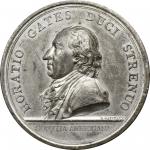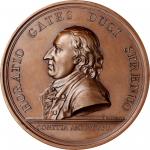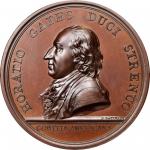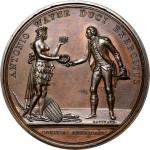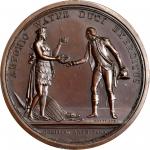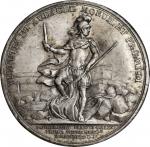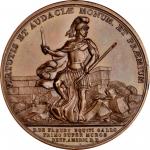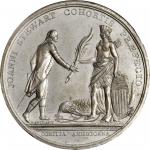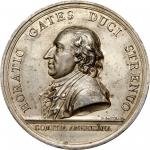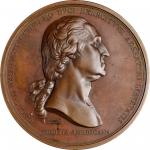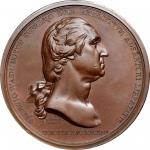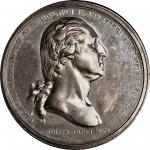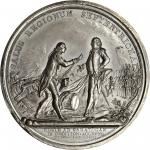1777 Horatio Gates at Saratoga medal. Betts-557, Julian MI-2. Tin. Philadelphia Mint. Original dies. 55.8 mm, 975.4 grains. 4.3 - 4.5 mm thick. Choice About Uncirculated.Plain squared edge with a collar mark or witness line at 6:00. An absolutely superb specimen, one of the finest seen of this tin emission, fully Mint State by most modern standards. The surfaces are lustrous and the fields retain nearly full reflectivity on both sides. The silver-white tin has assumed subtle highlights of gold and pale blue, but remains free of oxidation. The devices are struck into their best relief, with just a bit of flatness at the highest points of Gates hair. Some streaks of natural granularity are seen below the plane of the upper left obverse field, as made. Despite the fragile nature of soft-metal strikings such as this, few flaws are seen. Some very shallow old scratches are seen off the profile below GATES, a couple of trivial nicks are present on his cheek, and a single thin scratch descends from the clouds but stops before reaching Burgoynes nose on the reverse. The rims are clean, with a tiny bruise above E of GATES but little else to mention. Interestingly, the wire rim - called a "fin" at the early U.S. Mint and deemed a production error - was filed off at the time of striking to make the medal more perfect, but the edge cud in the lower left reverse is left alone, though later 19th century strikings almost always show the Mint habit of filing that rim cud flat. The overall eye appeal is flashy and a profound step up from typical specimens. This is among the very nicest weve encountered.<p>The die state is early, though measurably later than the Paris strikings. The rim break adjacent to the cannonballs at the left side of the exergual line is nowhere near as large as its broadest extent in post Civil War era strikings, but is still quite large. The break above 3:00 on the reverse is only slightly more advanced than Paris Mint strikings in copper and silver. The devices are crisply defined throughout. <p>The tradition that Aaron Burr delivered the Gates dies to the Philadelphia Mint in 1801 has always been clouded by a seeming lack of contemporary documentation. The Gates dies appeared on Franklin Peales 1841 "Register of the Medal Dies of the U.S.," a document of sufficient national interest that it was actually printed in the nationally distributed <em>Niles National Register</em> on August 3, 1844. Adams and Bentley quoted Julians account of the arrival of these dies at the Philadelphia Mint in 1801, not entirely convinced of Julians accuracy, and pondered whether Aaron Burr may have found the dies "at the Treasury of in the archives of the Secretary of State." The truth may be found in Burrs own letters, published in Volume II of his <em>Memoirs of Aaron Burr</em> (1837).<p><em>New-York, March 30, 1802 </em><p><em>My dear sir,</em><p><em>Yesterday I was favoured with your obliging letter of the 23d inst. by Mr. Peter Townsend; also, with a most beautiful silver medal from the die I have presented you. It is in the highest polish and perfection. In respect to the tin medal and its case, I have only heard of them from you, as I never received either, or a single line from Mr. Dallas. But men so much engaged in business seldom have time to attend such small affairs. …</em><p><em>Affectionately yours, </em><p><em>Horatio Gates</em><p>Aaron Burr received another relevant letter on May 25, 1802, from John Taylor of Caroline, who later served in the U.S. Senate representing Virginia. "Dear Sir," he wrote to Burr, "Your favour, covering the medal struck to commemorate the most brilliant exploit of the American war, from some cause unknown to me, never arrived until this instant. It is particularly acceptable from the circumstance of my having imbibed a personal affection for General Gates by having served under him for a few months."<p>We can discern a few important facts from these original documents: 1) Burr received the dies directly from Gates and deposited them at the Philadelphia Mint, 2) Burr had strikes made in both silver and tin, and sent Gates one of each, 3) Burr distributed these medals personally to his friends who shared his adoration of the general whom he preferred to Washington. Gates victory at Saratoga, coming on the heels of Washingtons losses in the Philadelphia Campaign of the fall of 1777, created a conspiratorial rivalry between the two generals in the minds of many, including the conspiracy-minded Burr. Burr was decidedly on Team Gates, and even 25 years later, his affection for Gates had not relented.<p>The tin Gates medals all show essentially identical die states, and all appear to have been struck at Burrs behest in 1801 or early 1802. They are rare. Ford owned only one (not quite as nice as this one, incidentally). LaRiviere likewise had one. Adams and Bentley called tin strikings R-7 and counted just seven of them. The three in this sale, plus Ford and LaRivieres, make five of that total, so we are inclined to believe the total surviving is slightly higher. Many come scruffy and tinpested, at least one is holed (Presidential Coin and Antique, December 1991), and one is known with a sprue or casting gate at 12:00 that suggests just how these planchets were made (New Netherlands 63rd sale - Harry Bass I, May 1999). Other specimens are noted in the Fewsmith sale of October 1870, George Cogans sale of May 1872, the great Bushnell sale of 1882, H.G. Sampsons final sale (June 1889), the fabulous Parsons sale of 1914 (described as showing "two dents on obv.)," and Frossards sale of October 1893. In modern times, they have been offered on at least three occasions in Presidential Coin and Antique sales, and Stacks and Stacks Bowers have sold five discrete specimens in the last 13 years since the Ford XIV offering (none prettier than Minot, May 2008:524 at $6,900). <p>An estimate of 20 survivors may be high, or it might be right on the money, but its not significantly misplaced either high or low. Among them, this ranks among the very top tier.<p><strong>The Battle of Saratoga</strong><p><p><strong>The Action:</strong><p>In the summer of 1777, the British military in North America sought to cleave the rebellious colonies in two. While Sir William Howe sailed up the Chesapeake Bay and landed troops at the Head of Elk to campaign against the rebel seat at Philadelphia, General John Burgoyne marched along the Champlain Valley water route from Canada - south via Lake Champlain, Lake George, and the Hudson River on the way to Albany. Burgoynes goal was to control the Champlain and Hudson valleys, and he endeavored to own this major north-south passage, with British held positions in Canada and New York City at either end, thereby cutting New England off from the mid-Atlantic states. Starting south across the border, Burgoynes force of nearly 8,000 consisted of about half British regulars supplemented with German mercenaries, Loyalists, and native allies. They took Fort Ticonderoga with little effort in July, but suffered a setback at the Battle of Bennington in August.<p>The Continental Army of the Northern Department, aided by the Bennington victory, saw its numbers swell in late August. Major General Horatio Gates took command on August 19, replacing Major General Phillip Schuyler. Even as Washington was charged with slowing Howes inevitable descent on Philadelphia, he saw opportunity against Burgoynes force. He sent Gates one of his most skilled officers - Benedict Arnold - along with Major General Benjamin Lincoln and the expert riflemen who served under Col. Daniel Morgan. <p>Gates first met Burgoyne at the Battle of Freemans Farm on September 19, 1777, the same week as Washingtons disaster at the Battle of Brandywine outside Philadelphia. Gates retreat preserved his force, while Burgoynes victory cost him hundreds of men. Burgoyne waited for his army to regain strength, fully expecting reinforcements to his depleted force. Gates knew his reinforcements were unlikely to appear.<p>On October 7, at the Battle of Bemis Heights, Gates and Burgoyne met once again. Gates had both superior numbers and superior intelligence; he also had Benedict Arnolds maverick plans and frenetic energy to both capitalize upon and control. Arnold led an American attack that took control of a position called the Breymann Redoubt, forcing the British troops to move. In two days, Burgoynes men found themselves hopelessly surrounded. After a weeks worth of negotiation and conversation, including a Council of War on October 13, Burgoyne agreed to surrender his entire army. Thousands of British and German troops were kept as prisoners of war, and the victory enabled Benjamin Franklin and others to successfully lobby King Louis XVI to assist the American effort.<p>Gates was proud of his role in this history-making triumph over the nation of his birth, writing to his wife on the day of the surrender "If Ole England is not by this lesson taught humility, then she is an obstinate old slut, bent upon her ruin."<p><strong>The Resolution:</strong><p><em>Resolved, That the thanks of Congress, in their own name, and in behalf of the inhabitants of the thirteen United States, be presented to Major General Gates, commander in chief in the northern department, and to Majors General Lincoln and Arnold, and the rest of the officers and troops under his command, for their brave and successful efforts in support of the independence of their country, whereby an army of the enemy of 10,000 men has been totally defeated, one large detachment of it, strongly posted and entrenched, having been conquered at Bennington, another repulsed with loss and disgrace from Fort Schuyler, and the main army of six thousand men, under Lieutenant General Burgoyne, after being beaten in different actions and driven from a formidable post, and strong entrenchments, reduced to the necessity of surrendering themselves upon advantageous to these states, on the 17 day of October last, to Major General Gates; and that a medal of gold be struck under the direction of the Board of War, in commemoration of this great event, and in the name of these United States, presented by the president to Major General Gates.</em><p><em>- Continental Congress Resolution of November 4, 1777</em><p><strong>The Acquisition:</strong><p>The day after Congress resolved to award Gates a gold medal, Henry Laurens of South Carolina wrote to the victorious general from Congress temporary seat in York, Pennsylvania in his capacity as President of Congress. <p><em>I feel myself particularly happy in the honour of transmitting the enclosed vote of thanks by Congress in their own name and in behalf of their constituents to yourself, to Major General Lincoln, Major General Arnold and the rest of the officers and troops under your command, with an additional vote for perpetuating the remembrance of this great event by a medal.</em><p><em>Your name Sir will be written in the breasts of the grateful Americans of the present age and sent down to posterity in characters which will remain indelible when the gold shall have changed its appearance. Permit me, sir, to add that I participate not only in the general rejoicing but in that also which is visible among your very best friends.</em><p>General Gates was anxious to receive his medal even before the war ended. In June 1779, he wrote again to Laurens, saying "I believe I am to wait until you are again President, before I shall receive my medal."<p>As it turned out, Gates medal was among the first for which arrangements were made. David Humphreys was the first American emissary to Paris charged with working on the Comitia Americana project, carrying instructions given by Robert Morris in June 1784. Humphreys, who served as secretary of the legation to Paris, engaged with Louis XVIs preferred medalist of the day, Nicolas-Marie Gatteaux, to execute the Gates medal. This process enters the known written recorded record in December 1785, when Jefferson is informed by Gatteaux that theres a problem with the portrait of Gates he was given: the general is depicted wearing the eagle badge of the Society of the Cincinnati, first instituted in 1784. Gatteaux wrote to Jefferson - why he didnt ask Humphreys isnt clear - if the medallic portrait of Gates should include this anachronism or not. Jefferson passed Gatteauxs query on to Humphreys on December 4, 1785:<p><em>I inclose you a letter from Gatteaux observing that there will be an anachronism, if, in making a medal to commemorate the victory of Saratoga, he puts on General Gates the insignia of the Cincinnati which did not exist at that date. I wrote him in answer that I thought so too: but that you had the direction of that business, that you were now in London, that I would write to you and probably should have an answer within a fortnight, and that in the mean time he could be employed on other parts of the die.</em><p>The exact print Gatteaux was first given is unclear, but from the portrait that Gatteaux ended up creating, its clear the eventual mother image was the popular engraving of Gates created from a portrait by Pierre Eugène du Simitière. Elvira Clain-Stefanellis suggestion that Gatteaux was initially using the extraordinarily crude engraving by John Norman seems highly unlikely.<p>The historical record on the creation of the Gates medal goes silent from the end of 1785 until early 1787, but clearly progress was being made.<p>The gold Gates medal had not been completed by the end of March when the March packet sailed for New York. On March 21, 1787, in the transmittal letter for Nathanael Greenes gold medal from William Short to John Jay, Short noted "the medal for Genl. Gates ordered by Congress and contracted for by Colo. Humphries (sic) is not yet finished; but will certainly be in time to be sent by the May Packet." The next day, in a letter to Jefferson, Short sounded less certain. "Mr. Walton who set out this morning for Havre took charge of the medals for Congress, that is those of Genl. Greene," Short wrote. "I have heard nothing farther from the engraver of Genl. Gatess."<p>Just a few days later, Short - who clearly had taken on responsibility for the Gates medal by this point - updated Jefferson again. "General Gatess medal is at length advanced to that point at which by the contract the engraver is entitled to receive 1200 [livres tournois]. I have told him I would write to you on the subject. He promises to finish it, without fail, in time to go by the May Packet. I think the likeness is very good considering the manner in which it has been taken." Jefferson forwarded an order for 1200 livres, drawn on the banker Ferdinand Grand, to Short on April 7 "for the workman who makes Genl. Gatess medal." On April 24, Short acknowledged the order had been received and paid over to Gatteaux. The deal had been completed.<p>In a wide-ranging and lengthy letter to John Jay dated May 4, 1787, Jefferson noted in his eleventh paragraph "I am in hopes Mr. Short will be able to send you the medals of General Gates by this packet. I await a general instruction as to these medals. The academies of Europe will be much pleased to receive each a set." <p>Short did not disappoint, addressing Jay the same day. "Sir, I have the honor of forwarding to your Excellency by M. de Crevecoeur the medal for Genl. Gates mentioned in my letter sent by Mr. Walter and accompanying that of Genl. Greene. M. de Crevecoeur takes charge also of twenty four medals of bronze to be delivered to your excellency. These have been made agreeably to the contract with Colo. Humphries (sic)."<p>The Gates medal was hand carried to the American continent by French writer and diplomat John Hector St. John de Crevecoeur, usually known as simply Crevecoeur, then serving as French consul at New York. Crevecoeur left Paris bound for New York on May 7, 1787, and in a letter from William Short to Jefferson the following day Short noted "Crevecoeur has gone for Havre, to sail from thence the 10th. He took with him the medals of Genl. Gates." Crevecoeur landed in New York in late June 1787 on board the Courrier de lEurope, carrying a letter of introduction to James Madison and accompanied in the passenger compartment by none other than John Paul Jones. Upon his arrival, Crevecoeur likely delivered the Gates medals - one in gold, 23 in bronze - to John Jay, who then delivered Gates own medal to Arthur St. Clair, the President of Congress.<p>Jefferson received and paid for the silver Gates medal struck for presentation to George Washington on July 4, 1789.<p><strong>The Presentation:</strong><p>The August 1787 presentation of Gates gold medal was a reunion of sorts. The medal was delivered into Gates hands by letter from Arthur St. Clair, whose abandonment of Fort Ticonderoga in July 1777 helped lead Burgoyne into Gates hands at Saratoga. Gates received St. Clairs letter of August 9, 1787 at his home, Travelers Rest, in what was then Berkeley County, Virginia and is today near Kearneysville, Jefferson County, West Virginia. He thanked St. Clair profusely on August 31, 1787.<p><em>Sir:-I had the honor to receive your Excellencys letter of the 9th inst., with the elegant medal in gold, which the most honorable the Congress, in their names, and in behalf of the inhabitants of the thirteen United States, were pleased to direct the Board of War to have struck and presented to me. Nothing could add to this distinguished mark of the favor and approbation of Congress but my receiving it in so polite a manner from the hands of your Excellency; from you, sir, whom, in the course of thirty years, I have so often had the honor to accompany on a vast variety of military service. </em><p><em>Permit me, likewise, to declare the satisfaction I feel in seeing your Excellencys merits crowned by the high station you now fill with such acknowledged ability. That the prosperity, honor, and happiness of the United States may last to the end of time, and that your Excellency may continue to enjoy the best blessings fortune can bestow, is my constant, ardent wish.</em><p><strong>The Horatio Gates at Saratoga Medal:</strong><p><strong>Obverse:</strong> A portrait of Gates to left, apparently based upon the Gates portrait by Pierre Eugène du Simitière; the dress is either civilian or intended to be military but mistakenly lacking his epaulet. Legend HORATIO GATES DUCI STRENUO (Horatio Gates, valiant general or energetic leader). COMITIA AMERICANA (American Congress) in exergue.<p><strong>Reverse:</strong> Gates upright at right, holding his hat and extending his right hand, Burgoyne on bent knee offering sword at left. Burgoynes troops, in left background, furl flags and lay down their arms. An artillery piece points away. At center background, a furled flag is laid over a drum. At right left background, American troops stand tall with shouldered arms surmounted by bayonets. A sword-wearing officer stands in front of the American line. A single flag is raised at right. At left end of the exergual line, a grouping of cannonballs. At right end, a victory laurel. Main legend SALUS REGIONUM SEPTENTRIONAL (Safety in the northern regions). In exergue, HOSTE AD SARATOGAM INDEDITION ACCEPTO DIE XVII OCT MDCCLXXVII (Advancing to the surrender of Saratoga, October 17, 1777). <p>From the John W. Adams Collection. Acquired from Paul Patterson, June 1986.


